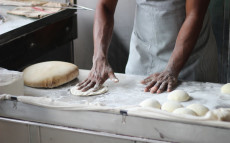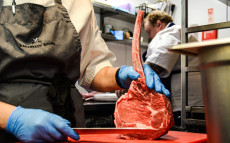- pathfindersAI
- Job Profile
Cooks, Restaurant
Summary
The Role of Cooks in the Restaurant Industry
What They Do
Cooks in restaurants play a pivotal role in the culinary arts, transforming raw ingredients into delectable dishes that delight the senses. They work in a variety of establishments, ranging from small cafes to large, upscale dining venues. Their primary responsibility is to prepare, cook, and present food according to recipes and customer specifications. Whether it's a perfectly seared steak or a delicate French pastry, restaurant cooks are the artisans behind the flavors that keep customers returning.
Job Responsibilities
Cooks in restaurant settings bear a multitude of responsibilities that extend beyond merely assembling ingredients. Their day-to-day tasks include ensuring the freshness and quality of the ingredients used, maintaining cleanliness and organization in the kitchen, and adhering to food safety standards. Additionally, they must be skilled in various cooking techniques such as grilling, frying, baking, and sautéing. A cook’s job also entails collaborating closely with other kitchen staff to ensure a smooth and efficient service, particularly during peak hours. From inventory management to plating dishes, each responsibility is integral to the restaurant's overall success.
Essential Skills
To excel as a cook in a restaurant, several essential skills are paramount. First and foremost, a profound understanding of various cooking techniques and cuisines is crucial. Dexterity and precision are also vital, as cooks often work in fast-paced environments where timing can make or break a dish. Strong communication skills are necessary for effective teamwork and coordination with other kitchen staff. Furthermore, creativity and innovation can set a cook apart, enabling them to craft unique, signature dishes that elevate a restaurant's reputation. Attention to detail and the ability to follow recipes meticulously ensure consistency and quality in every meal prepared.
Educational Pathways
Aspiring restaurant cooks have multiple educational pathways to embark on this rewarding career. While some may enter the profession through hands-on experience and apprenticeships, formal education can provide a substantial advantage. Culinary institutes and community colleges offer specialized programs in culinary arts that cover fundamental cooking techniques, nutrition, and kitchen management. Additionally, certificates and associate degrees can enhance a cook’s employability and open doors to more prestigious dining establishments. On-the-job training and continuous learning are also integral, as the culinary field is ever-evolving with new trends and techniques.
Career Prospects
The career prospects for restaurant cooks are diverse and promising. Entry-level positions often serve as stepping stones to more advanced roles such as sous chef or head chef. As cooks gain experience and refine their skills, opportunities in management, menu planning, and even ownership of a culinary business may arise. The demand for skilled cooks remains robust, driven by the public’s increasing interest in diverse cuisines and dining experiences. Additionally, the growth of food tourism and the popularity of cooking shows have further heightened the allure of this career.
Conclusion
In conclusion, the role of cooks in restaurants is both challenging and gratifying, requiring a blend of technical skills, creativity, and teamwork. With various educational pathways and robust career prospects, it is a profession that offers numerous opportunities for growth and advancement. Those who are passionate about the culinary arts will find that a career as a restaurant cook not only satisfies their love for food but also provides a dynamic and fulfilling professional journey.
Video
Compensation
| State | Median Salary | Median Hourly | Positions |
|---|---|---|---|
| AL | 28,940 | 13.91 | 17,450 |
| AK | 37,160 | 17.87 | 2,230 |
| AZ | 37,460 | 18.01 | 28,400 |
| AR | 28,880 | 13.88 | 11,880 |
| CA | 41,400 | 19.90 | 145,810 |
| CO | 38,130 | 18.33 | 33,120 |
| CT | 36,830 | 17.71 | 14,430 |
| DE | 33,560 | 16.14 | 5,720 |
| DC | 38,120 | 18.33 | 6,960 |
| FL | 35,120 | 16.89 | 130,820 |
| GA | 30,400 | 14.62 | 50,770 |
| HI | 41,500 | 19.95 | 12,120 |
| ID | 34,160 | 16.42 | 7,670 |
| IL | 36,300 | 17.45 | 54,010 |
| IN | 30,580 | 14.70 | 26,170 |
| IA | 32,090 | 15.43 | 12,750 |
| KS | 32,310 | 15.54 | 11,210 |
| KY | 29,400 | 14.14 | 15,170 |
| LA | 28,710 | 13.80 | 14,920 |
| ME | 38,700 | 18.61 | 5,250 |
| MD | 35,810 | 17.21 | 20,660 |
| MA | 43,560 | 20.94 | 31,620 |
| MI | 35,250 | 16.95 | 37,090 |
| MN | 37,480 | 18.02 | 27,440 |
| MS | 28,950 | 13.92 | 9,740 |
| MO | 33,630 | 16.17 | 32,850 |
| MT | 34,880 | 16.77 | 6,810 |
| NE | 35,230 | 16.94 | 4,960 |
| NV | 36,490 | 17.54 | 25,540 |
| NH | 37,930 | 18.24 | 6,520 |
| NJ | 37,250 | 17.91 | 26,690 |
| NM | 30,150 | 14.49 | 9,350 |
| NY | 39,110 | 18.80 | 67,870 |
| NC | 34,020 | 16.36 | 47,380 |
| ND | 35,340 | 16.99 | 4,130 |
| OH | 30,980 | 14.89 | 51,180 |
| OK | 29,910 | 14.38 | 15,760 |
| OR | 36,690 | 17.64 | 18,740 |
| PA | 32,210 | 15.49 | 54,980 |
| RI | 37,850 | 18.20 | 6,890 |
| SC | 31,870 | 15.32 | 27,070 |
| SD | 33,940 | 16.32 | 1,410 |
| TN | 34,260 | 16.47 | 29,160 |
| TX | 30,600 | 14.71 | 123,920 |
| UT | 37,120 | 17.85 | 11,300 |
| VT | 44,000 | 21.15 | 2,500 |
| VA | 34,890 | 16.78 | 38,210 |
| WA | 43,990 | 21.15 | 30,050 |
| WV | 28,100 | 13.51 | 7,060 |
| WI | 35,870 | 17.24 | 25,520 |
| WY | 30,370 | 14.60 | 3,110 |
Similar Occupations
In this area you will find other occupations that are close to the one you were viewing in tasks, knowledge and work environment. If the primary job profile you are viewing isn't quite to your liking, take a look around and see what else is available.
Basic and Premium Accounts have more alternative occupations available than the Free account.

Bakers - 51-3011.00
A baker prepares and bakes various types of breads, pastries, and other baked goods by mixing ingredients, kneading dough, and monitoring baking times and temperatures. They often work early hours to ensure fresh products are available for customers each day.
-
$34,950/yr
Median Pay -
220,230
Number of Jobs

Butchers and Meat Cutters - 51-3021.00
Butchers and Meat Cutters are professionals responsible for preparing meat for consumer use by slaughtering, deboning, trimming, and cutting into various types of cuts, ensuring optimal quality and portion control. They also handle the storage, packaging, and display of meat products, adhering to sanitary and safety standards.
-
$37,650/yr
Median Pay -
136,330
Number of Jobs